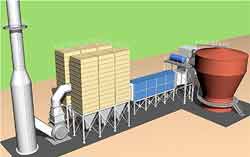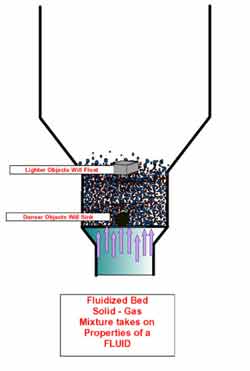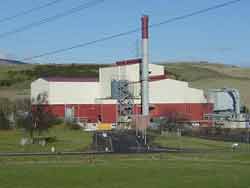Alternatives to Natural Gas: More Cost-Efficient Ways to Generate Steam







February 1, 2006
BY Mitch Gorski
A common concern of ethanol producers is the cost of energy to generate process steam. Traditionally, steam is generated by firing natural gas in an industrial boiler, but with America's use of natural gas outpacing supply—and the resulting increase in price—ethanol producers are exploring distillers grains, solubles and other biomass residues as a less expensive source of energy. Utilizing biomass fuels as a means of providing process steam at dry-grind ethanol plants can also improve the renewable energy ratio of ethanol production.
Biomass residues are just one alternative source to natural gas. Used with the right energy conversion technology, a wide variety of fuels can be cost-efficient alternatives.
The fuel choices
Distillers wet grains and condensed solubles have significant energy potential. Depending on the market situation of natural gas compared to DDGS, it may be more cost-effective to burn DDGS as fuel rather than convert to animal feed. Agricultural or crop residues leftover from harvesting, such as corn stover, can be collected and are another potential biomass energy source for ethanol plants. Animal waste, such as cattle, chicken, turkey and pig manure, can also be burned directly for power generation. Biofuels are also seen as a more environmentally friendly substitute for fossil fuels since the short carbon cycle of growing, harvesting, burning and re-growing biofuels contributes less to global warming, (biomass is seen as a CO2 neutral fuel).
Although coal is location dependent, it is another fuel that has the potential to reduce fuel costs.
Most dry-grind ethanol plants are required to control volatile organic compounds (VOC) emissions present in the exhaust of distillers grains dryers. As a result, thermal oxidizers with steam-heat-recover steam generators have been employed to destroy the VOCs and generate steam. An option for some installations for VOC destruction is to use the exhaust from the distillers grains dryer as combustion air for the energy conversion unit. This approach can provide the VOC emission reductions and displace the fossil fuels used to fire the thermal oxidizer, further improving the payback for the energy conversion system.
The technology choices
Since fuel property characteristics differ between wet cake and condensed solubles, agricultural residues, animal waste, coal and urban wood waste, it is essential to evaluate the fuel and to study the energy conversion technology options. Burning alternative fuels requires fuel flexibility and reliable technology, plus good combustion efficiency with low emissions. Several energy conversion technologies are well-suited for the range of alternative fuels an ethanol plant may consider as fuel.
The use of a spreader stoker-fired system to fire coal and biomass has been the typical technology of choice for industrial-sized applications. As the name implies, the spreader stoker projects fuel into the furnace over a traveling grate, which permits suspension burning of the finer particulate. The larger particles that cannot be supported by the gas fall to the grate, where they form a thin, fast-burning bed. The traveling grate moves from the back of the furnace to the front, where the ash is discharged into an ash hopper. The most attractive feature of the stoker-fired system is its relatively low capital cost. On the other hand, stoker-fired systems have had difficulty meeting new emission standards and have had lower boiler plant efficiency. Changes in fuel particle size and density make it difficult to maintain proper combustion conditions, and higher carbon levels are typically seen in the stoker ashes, making the ash less suitable for profitable uses.
In a fluidized bed boiler, another technique for burning fuel, a bed of inert granulated material, typically sand, is suspended by an upward flow of air introduced through an orifice plate or air distribution manifold below the bed (see figure 1). The high thermal inertia of the bed mass provides for stable combustion of fuels high in moisture and ash. Fuels with up to 80 percent moisture are typically burned in a fluid bed. Since it is designed to tightly control bed temperatures, a fluidized bed offers greater combustion efficiency and reduced emissions compared to a stoker-fired system. The use of limestone as a sulfur-capture sorbent allows the sulfur emissions to be controlled within the combustion process.
Fluidized bed boilers fall into two major categories, each operating in a different state of fluidization: bubbling fluidized beds and circulating fluidized bed boilers.
A bubbling bed boiler consists of a refractory lined vessel or water wall tube furnace, where gases are blown through the bed material at a rate sufficiently high enough to cause the bed to expand and act as a fluid. The gases are injected through a horizontal air distribution plate at the bottom of the vessel. Nozzles that permit flow up into the bed restrict downflow of the bed material.
Circulating fluidized bed boilers consist of bed/furnace and a cyclone. In circulating fluidized bed boilers, the fuel and sand are suspended in a stream of upwardly flowing air within the furnace, and then are collected by a cyclone and circulated back into the furnace. Because of their continual recirculation,circulating fluidized beds allow for firing of fuels with varied heating values and ash contents while bubbling fluidized bed boilers are restricted to a narrower range of fuels.
In bubbling bed boilers, fuel heat is released in both the bed and the furnace. Bed temperature is maintained through heat transfer to furnace wall tubes and bed tubes, or the fuel must have significant moisture to absorb the heat. Dependent upon the moisture content of the fuels and the steam production requirements, bubbling fluidized bed boilers can have either a refractory-lined furnace or a waterwall tube design. In circulating bed boilers, bed temperatures are uniform because of the internal recirculation of the bed.
The question of selecting between a bubbling fluidized bed and circulating fluidized bed is difficult to answer. In certain cases, such as burning coal with low emissions or the requirement to use a wide range of fuels with varying heating values, a circulating fluidized bed boiler may be the only choice. However, for most biomass applications where distillers wetcake or syrup, or corn stover is used as fuel, a bubbling fluidized bed with a refractory lined furnace or water wall tube construction is the recommended choice. Another factor that influences the decision between bubbling fluidized bed and circulating bed is unit capacity. A circulating fluidized bed boiler is better suited where the steam production requirements are greater than 175,000 pounds per hour, with steam temperatures greater than 750 degrees Fahrenheit and pressures greater than 300 pounds per square inch gauge (psig).
Many alternative and biomass fuels contain "tramp" or foreign material ranging from rocks to metal debris. If allowed to build up, this material will eventually contaminate the bed to the point where proper fluidization is not possible. If a significant amount of tramp material is anticipated with the fuel, a bed drawdown and cleaning system is typically supplied to remove tramp material and control the bed level. The bed material is processed to remove the oversized tramp material before re-injecting the acceptably sized material into the bed.
Another choice for producing energy for an ethanol plant is biomass gasification. Biomass gasification is the oxygen-starved partial oxidation of solid fuel. It produces a syngas that can be run through a combined-cycle gas engine or another power conversion technology. Most commercial installations built to date have been small-scale and have mainly used wood chips as fuel. Gasification systems have environmental benefits but currently cost more because of the complexity of the gasification system and the cost to clean the syngas before being combusted in a turbine. As the next generation of gasification plants are built, costs should decrease while their reliability increases will enable more widespread use.
Burning alternative materials that are easily gathered and close to the plant can provide useful, cost-efficient energy for an ethanol plant. Defining the lowest cost option while balancing fuel flexibility requires careful evaluation of the costs and benefits of the variety of fuels and technologies commercially available. EP
Mitch Gorski is vice president and general manager of AE&E-Von Roll Inc. Reach him at mitch.gorski@aee-vonroll.com or (770) 248-7444.
Biomass residues are just one alternative source to natural gas. Used with the right energy conversion technology, a wide variety of fuels can be cost-efficient alternatives.
The fuel choices
Distillers wet grains and condensed solubles have significant energy potential. Depending on the market situation of natural gas compared to DDGS, it may be more cost-effective to burn DDGS as fuel rather than convert to animal feed. Agricultural or crop residues leftover from harvesting, such as corn stover, can be collected and are another potential biomass energy source for ethanol plants. Animal waste, such as cattle, chicken, turkey and pig manure, can also be burned directly for power generation. Biofuels are also seen as a more environmentally friendly substitute for fossil fuels since the short carbon cycle of growing, harvesting, burning and re-growing biofuels contributes less to global warming, (biomass is seen as a CO2 neutral fuel).
Although coal is location dependent, it is another fuel that has the potential to reduce fuel costs.
Most dry-grind ethanol plants are required to control volatile organic compounds (VOC) emissions present in the exhaust of distillers grains dryers. As a result, thermal oxidizers with steam-heat-recover steam generators have been employed to destroy the VOCs and generate steam. An option for some installations for VOC destruction is to use the exhaust from the distillers grains dryer as combustion air for the energy conversion unit. This approach can provide the VOC emission reductions and displace the fossil fuels used to fire the thermal oxidizer, further improving the payback for the energy conversion system.
The technology choices
Since fuel property characteristics differ between wet cake and condensed solubles, agricultural residues, animal waste, coal and urban wood waste, it is essential to evaluate the fuel and to study the energy conversion technology options. Burning alternative fuels requires fuel flexibility and reliable technology, plus good combustion efficiency with low emissions. Several energy conversion technologies are well-suited for the range of alternative fuels an ethanol plant may consider as fuel.
The use of a spreader stoker-fired system to fire coal and biomass has been the typical technology of choice for industrial-sized applications. As the name implies, the spreader stoker projects fuel into the furnace over a traveling grate, which permits suspension burning of the finer particulate. The larger particles that cannot be supported by the gas fall to the grate, where they form a thin, fast-burning bed. The traveling grate moves from the back of the furnace to the front, where the ash is discharged into an ash hopper. The most attractive feature of the stoker-fired system is its relatively low capital cost. On the other hand, stoker-fired systems have had difficulty meeting new emission standards and have had lower boiler plant efficiency. Changes in fuel particle size and density make it difficult to maintain proper combustion conditions, and higher carbon levels are typically seen in the stoker ashes, making the ash less suitable for profitable uses.
In a fluidized bed boiler, another technique for burning fuel, a bed of inert granulated material, typically sand, is suspended by an upward flow of air introduced through an orifice plate or air distribution manifold below the bed (see figure 1). The high thermal inertia of the bed mass provides for stable combustion of fuels high in moisture and ash. Fuels with up to 80 percent moisture are typically burned in a fluid bed. Since it is designed to tightly control bed temperatures, a fluidized bed offers greater combustion efficiency and reduced emissions compared to a stoker-fired system. The use of limestone as a sulfur-capture sorbent allows the sulfur emissions to be controlled within the combustion process.
Fluidized bed boilers fall into two major categories, each operating in a different state of fluidization: bubbling fluidized beds and circulating fluidized bed boilers.
A bubbling bed boiler consists of a refractory lined vessel or water wall tube furnace, where gases are blown through the bed material at a rate sufficiently high enough to cause the bed to expand and act as a fluid. The gases are injected through a horizontal air distribution plate at the bottom of the vessel. Nozzles that permit flow up into the bed restrict downflow of the bed material.
Circulating fluidized bed boilers consist of bed/furnace and a cyclone. In circulating fluidized bed boilers, the fuel and sand are suspended in a stream of upwardly flowing air within the furnace, and then are collected by a cyclone and circulated back into the furnace. Because of their continual recirculation,circulating fluidized beds allow for firing of fuels with varied heating values and ash contents while bubbling fluidized bed boilers are restricted to a narrower range of fuels.
In bubbling bed boilers, fuel heat is released in both the bed and the furnace. Bed temperature is maintained through heat transfer to furnace wall tubes and bed tubes, or the fuel must have significant moisture to absorb the heat. Dependent upon the moisture content of the fuels and the steam production requirements, bubbling fluidized bed boilers can have either a refractory-lined furnace or a waterwall tube design. In circulating bed boilers, bed temperatures are uniform because of the internal recirculation of the bed.
The question of selecting between a bubbling fluidized bed and circulating fluidized bed is difficult to answer. In certain cases, such as burning coal with low emissions or the requirement to use a wide range of fuels with varying heating values, a circulating fluidized bed boiler may be the only choice. However, for most biomass applications where distillers wetcake or syrup, or corn stover is used as fuel, a bubbling fluidized bed with a refractory lined furnace or water wall tube construction is the recommended choice. Another factor that influences the decision between bubbling fluidized bed and circulating bed is unit capacity. A circulating fluidized bed boiler is better suited where the steam production requirements are greater than 175,000 pounds per hour, with steam temperatures greater than 750 degrees Fahrenheit and pressures greater than 300 pounds per square inch gauge (psig).
Many alternative and biomass fuels contain "tramp" or foreign material ranging from rocks to metal debris. If allowed to build up, this material will eventually contaminate the bed to the point where proper fluidization is not possible. If a significant amount of tramp material is anticipated with the fuel, a bed drawdown and cleaning system is typically supplied to remove tramp material and control the bed level. The bed material is processed to remove the oversized tramp material before re-injecting the acceptably sized material into the bed.
Another choice for producing energy for an ethanol plant is biomass gasification. Biomass gasification is the oxygen-starved partial oxidation of solid fuel. It produces a syngas that can be run through a combined-cycle gas engine or another power conversion technology. Most commercial installations built to date have been small-scale and have mainly used wood chips as fuel. Gasification systems have environmental benefits but currently cost more because of the complexity of the gasification system and the cost to clean the syngas before being combusted in a turbine. As the next generation of gasification plants are built, costs should decrease while their reliability increases will enable more widespread use.
Burning alternative materials that are easily gathered and close to the plant can provide useful, cost-efficient energy for an ethanol plant. Defining the lowest cost option while balancing fuel flexibility requires careful evaluation of the costs and benefits of the variety of fuels and technologies commercially available. EP
Mitch Gorski is vice president and general manager of AE&E-Von Roll Inc. Reach him at mitch.gorski@aee-vonroll.com or (770) 248-7444.
Advertisement
Advertisement
Advertisement
Advertisement
Upcoming Events





